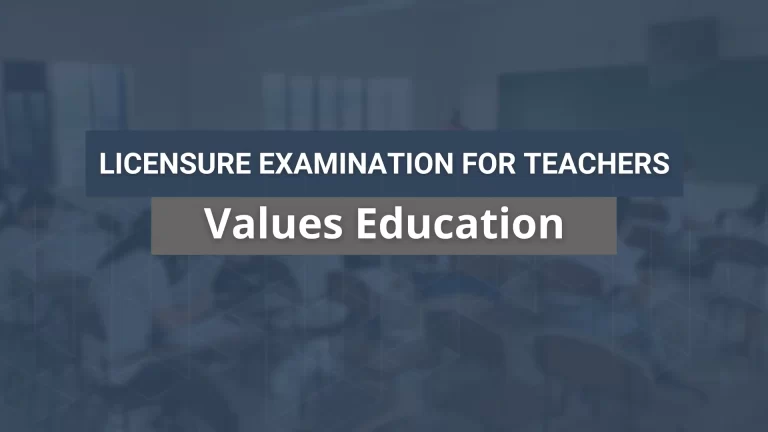This is the Multiples Choice Questions Part 4 of Values Education. In preparation for the LET Exam, practice, and familiarize every question we have, it might be included in the actual examination. Good luck.
Be fully prepared for your exam, follow our tips on effective studying and test-taking strategies. Click here to read the tips:
Values Education Part 4
1. Which of the following will help strengthen family?
a. Engaging in civic work
b. Lending hand to the poor
c. Communication with family members
d. Working, playing and praying together
Answer: d
2. Which of the following gives premium to individualistic desire, pleasure and conscience?
a. Pragmatism
b. Liberation
c. Utilization
d. Hedonism
Answer: a
3. Which of the following strategies should be directly observed to foster accountability?
a. Encourage growth of self esteem
b. Demand official receipts in business transaction
c. School curricula should be oriented to self-reliance
d. Award government employees who demonstrate desirable behavior
Answer: c
4. Which of the following is a manifestation of a lack discipline?
a. Palusot syndrome
b. Sustainable projects
c. Observance of time schedule
d. Qualification standardization
Answer: a
5. What is implied in this statement: “Adapting to change id = s adapting to modernity”
a. Change does not necessarily mean forgetting tradition
b. If one has to change, it must be a change for the better
c. All changes are new and modern
d. Not all changes are modern
Answer: d
6. What is the school’s ethnical responsibility?
a. Understand the child’s pattern of growth and development
b. Instill the spirit of absolute freedom in action
c. Teach values separately form concept
d. Transmit culture
Answer: c
7. On which must be base your class assessment affective learning?
a. Class activity
b. Text book
c. Topic
d. Learning objective
Answer: c
8. Which assessment technique can help a Values Education Teacher determine if a favorable change in her students’ thoughts and attitudes has taken place?
a. Making students to do sociogram
b. Organizing them for a group project
c. Giving them cognitive question to answer
d. Asking student to write a brief autobiography
Answer: b
9. Which of the following is the correct order of the valuing process?
a. Prizing, choosing, acting
b. Acting, choosing, prizing
c. Choosing, prizing, acting
d. Choosing, acting, prizing
Answer: a
10. What type of conscience judges “what is good and what is evil as evil?
a. Lax conscience
b. True conscience
c. Partially true conscience
d. Scrupulous conscience
Answer: a
11. The objective of the will is:
a. Goodness
b. Harmony
c. Peace
d. Understanding
Answer: d
12. Which of the following is an indication of the human being’s inclination towards spirituality?
a. Becoming a religious person
b. Becoming spiritual as one grows older
c. Elevating one’s material self to spiritual self
d. Satisfying one’s material needs a head of spiritual needs
Answer: c
13. What could be the first help for school aged children top develop their sense of competence and industry?
a. Strict rules to follow for betting accomplishment
b. Give opportunities for work so they accomplish more
c. Facilitate personal satisfaction and pride in their accomplishment
d. Don’t reinforce every may become depended on reinforcement
Answer: b
14. Since private property has a social dimension, what is demand by justice?
a. Keep he properly as hidden capital
b. Give away what we have to those who have none
c. Develop what we have and share the fruit of development with others
d. Donate what we have to government for distribution to those who have less
Answer: b
15. Which of the following is NOT an effective time management?
a. Setting goals and priorities
b. Avoiding procrastination
c. Acting on impulse and delays
d. Evaluating progress towards goals
Answer: c
16. Which of the following should be considered in order to combat the negative factors that destroy the solidarity of the Filipino family?
a. Strengthen faithfulness of husband to their wives
b. Seek help from all sectors of the community
c. Be responsible member of their families
d. Believe in a formidable family
Answer: b
17. Which behavior shows that you can think/ act locally and globally at the same time?
a. Patronize indigenous culture
b. Maintain global awareness on various issues
c. Travel to many attractive place around the world
d. Be proud of the local products, export the same for consumption
Answer: d
18. What are the factors that contribute to the family’s success in values formation for their children?
I. Effective child rearing methods
II. Empathy and well directed love foe the children
III. Schooling experiences and religious instruction
IV. Permissive and modern ways of bringing up children
a. I, II and IV
b. I, III and IV
c. II, III and IV
d. II and IV
Answer: c
19. Which is a technique used in a qualitative evaluation of values development?
a. Teacher made examination
b. Semantic differential scale
c. Achievement test
d. Diagnostic test
Answer: a
20. What level of affective domain is develop if he teacher wanted to enhance the student’s sensitivity to the feelings and needs of others?
a. Receiving
b. Responding
c. Characterization
d. Valuing
Answer: a


